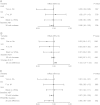The effect of hepatitis C virologic clearance on cardiovascular disease biomarkers in human immunodeficiency virus/hepatitis C virus coinfection
- PMID: 25734172
- PMCID: PMC4324212
- DOI: 10.1093/ofid/ofu104
The effect of hepatitis C virologic clearance on cardiovascular disease biomarkers in human immunodeficiency virus/hepatitis C virus coinfection
Abstract
Background: Successful hepatitis C virus (HCV) treatment may reduce cardiovascular disease (CVD) risk and improve levels of CVD biomarkers produced outside the liver (nonhepatic biomarkers).
Methods: Stored serum or plasma from before and 24 weeks after end of HCV treatment (EOT) from human immunodeficiency virus (HIV)/HCV-coinfected subjects who received up to 72 weeks of peginterferon/ribavirin, 27 with and 27 without sustained virologic response (SVR) matched by race, ethnicity and sex, were tested for nonhepatic (soluble intercellular adhesion molecule-1 [sICAM-1], soluble P-selectin [sP-selectin], interleukin [IL]-6, d-dimer, and lipoprotein-associated phospholipase A2 [Lp-PLA2]) and hepatic (cholesterol and high-sensitivity C-reactive protein) CVD and macrophage activation markers (soluble CD163 [sCD163] and soluble CD14). Changes in biomarkers and their association with SVR were examined by t tests or Wilcoxon tests and regression models.
Results: Of the 54 subjects, 30 were white, 24 were black, and 44 were male. Pretreatment levels of nonhepatic biomarkers were high: sICAM-1 overall median, 439.2 ng/mL (interquartile range [IQR], 365.6-592.8]; sP-selectin, 146.7 ng/mL (IQR, 94.1-209.9), and IL-6, 2.32 pg/mL (IQR, 1.61-3.49). Thirty-seven of 52 (71%) subjects had Lp-PLA2 >235 ng/mL. Sustained virologic response was associated with decrease in sICAM-1 (P = .033) and sCD163 (P = .042); this result was attenuated after controlling for changes in the alanine aminotransferase level. At 24 weeks after EOT, 17 (63%) SVRs had Lp-PLA2 >235 ng/mL vs 25 (93%) non-SVRs (P = .021).
Conclusions: Hepatitis C virus clearance may reduce hepatic and, subsequently, systemic inflammation and CVD risk in HIV/HCV coinfection.
Keywords: HIV/HCV coinfection; cholesterol; macrophage activation; sustained virologic response; vascular adhesion molecules.
Figures




References
-
- Hernando V, Perez-Cachafeiro S, Lewden C, et al. All-cause and liver-related mortality in HIV positive subjects compared to the general population: differences by HCV co-infection. J Hepatol. 2012;57:743–51. - PubMed
Grants and funding
LinkOut - more resources
Full Text Sources
Other Literature Sources
Research Materials

